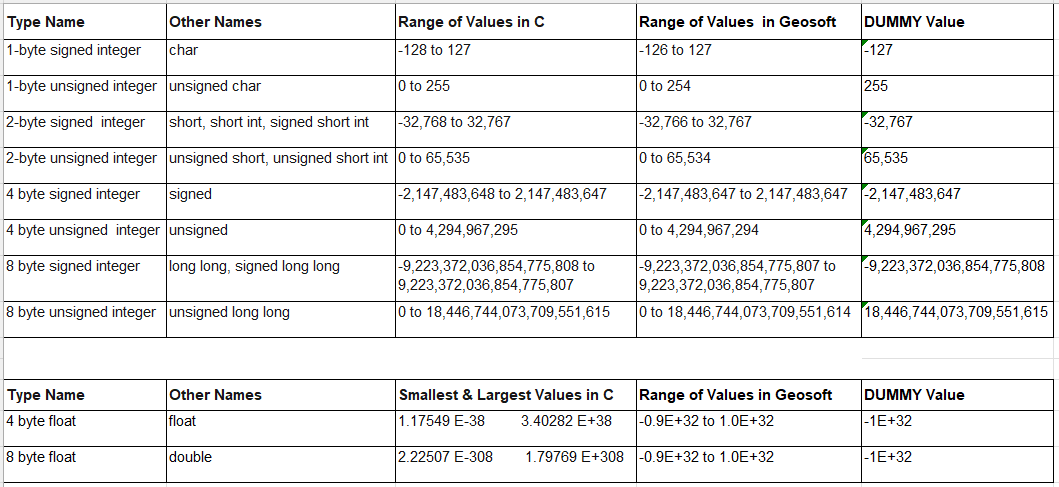Grid Math
Use the Grid and Image > Grid Math menu option (geogxnet.dll(Geosoft.GX.MathExpressionBuilder.MathExpressionBuilder;RunGrid)*) to create, save, load, and execute math expressions for your grid data. This easy-to-use, standardized dialog provides all the math expression options on a single tabbed dialog.
Grid Math dialog options
|
Step 1: Enter a mathematical expression, or alternatively, build the expression using the buttons and tabs located below the Expression box. |
|
|
Expression |
Enter the math expression in this box. The syntax is straightforward and based on the C programming language. The expression can contain any combination of functions and operators, absolute and/or variable grid names, DUMMY values, and numbers, spanning multiple equations. The expression can either be directly typed in or built using the supplied Variables and Operators and Functions tabs. For further details, see the Expression section under Application Notes. |
|
|
Click this button to expand and display the available Operators and Functions to build the Grid Math expression. Use the keyboard to enter numerical values. For more detailed information about the operators and functions in this expanded section, click on the links below:
|
|
|
Click this button to add a new grid variable at the cursor's location in the Expression box. The variable grid naming convention is G#, where # is the next available number. This is not to be confused with temporary variables (see Common Keys), which only exist at runtime and are not saved. |
|
Step 2: Assign grids to the variable names used in the expression. |
|
|
Assign grids |
This box is populated with all the grid variables present in the Expression box. Each variable can be set either by choosing a grid from the drop-down list of the grids used in the current project or by using the browse button to navigate and select the appropriate grid. The tool distinguishes between input and output grids. Input grids must exist and are preceded by a For further details, see the Assign Grids section under Application Notes. |
|
Common tasks |
To speed up building the expression, this drop-down list offers a number of simple common math expressions:
You can select an expression from the list and, if needed, continue to further edit it. G0 = (condition)?G2:G3, the data type of the rightmost channel, G3, defines the data type of the output.
|
|
Expression file |
Once you have built the expression, you can save it to a file for future use. Similarly, if you have previously saved expressions, you can load them from file. The expression files are simple ASCII text files and can be viewed outside of Oasis montaj using a text editor. |
|
|
Click on Clear to remove all entries, including the expression, grid assignment, and expression file. |
|
|
Click on Apply to apply the expression without exiting the dialog. This is useful when you intend to apply the same expression to multiple grids. |
Application Notes
If an equation yields a value outside the data range, the output is set to DUMMY.
In Geosoft convention, the DUMMY value depends on the data type:
-
For signed integer data types, the DUMMY value is set to the minimum value of the corresponding data range.
-
For unsigned integer data types, the DUMMY value is set to the maximum value of the corresponding data range.
-
The DUMMY values and data ranges for floating data types do not follow this convention. Instead, they are set to limits outside the data ranges you would typically handle in geophysical processing.
The table below provides the Geosoft data ranges and DUMMY values for the different data types:
Expression
Expressions are parsed from right to left. For example, in the conditional expression G0 = (condition)?G2:G3, the data type of the rightmost channel, G3, defines the data type of the output.
Longer, more complex expressions spanning multiple lines will remain in view. As you add new rows to the Expression box, the height of the box automatically increases to show up to 12 lines, after which a scroll bar appears along the right margin of the expression box.
To further increase the vertical height of the box, while the focus is on the expression box, hover the cursor over the top or bottom edge of the dialog until you see the double arrows. Then, click and drag the edge of the dialog, and the expression box will grow accordingly.
When working with long expressions, you can widen the dialog by hovering the cursor over the left or right edge of the dialog until you see the double arrow. Then, click and drag the edge of the dialog to the appropriate size.
Assign Grids
To further increase the vertical height of the Assign grids box, while the focus is on it, hover the cursor over the top or bottom edge of the dialog until you see the double arrows. Then, click and drag the edge of the dialog, and the Assign grids box will grow accordingly.
You will not see the temporary variable listed in this window.
*The GX.NET tools are embedded in the geogxnet.dll file located in the "...\Geosoft\Desktop Applications \bin" folder. If running this GX interactively, bypassing the menu, first change the folder to point to the "bin" directory, then supply the GX.NET tool in the specified format. See the topic Run GX for more details on running a GX.NET interactively.
Got a question? Visit the Seequent forums or Seequent support
© 2024 Seequent, The Bentley Subsurface Company
Privacy | Terms of Use



 , while you can enter the output grid name.
, while you can enter the output grid name.

